Your website could be the best salesperson you ever hire. All it takes is implementing some modern website design principles to optimize it.
Think of it this way: A website is often the first point of interaction people have with a small business. That makes it incredibly important; not only as the primary platform for making initial impressions, but also in influencing decisions and persuading potential customers to take action in future visits.
A well-designed, modern website is capable of immediately presenting a professional image for your business, attracting an audience of potential customers, and eventually converting site visitors into loyal customers. It can effectively communicate the story of your brand, showcase your products or services, and engage users in a way that drives sales. And it works 24/7, doesn’t take commissions, never goes on holidays, and always returns your investment into it.
Yet, many small businesses aren’t realizing all the benefits a modern website can provide — simply because they’re not thinking of it as the powerful sales and marketing tool that it is.
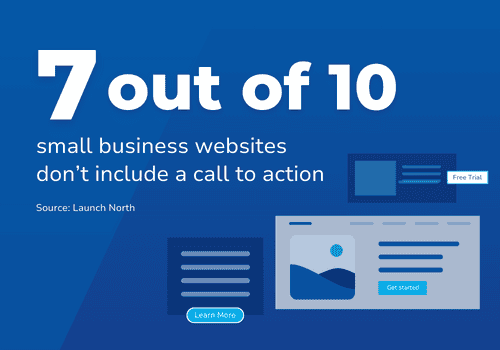
By implementing modern website design best practices, your website becomes a strategic asset, a cost-effective way to differentiate your small business in a crowded market and create meaningful interactions with potential customers.
In this article, we’re going to identify 10 modern website design features that will not only help you stand out from the competition and generate leads, but also convert those leads into sales. These features are essential for any small business owner looking to transform their website into the company’s best seller.
What Does ‘Modern Website Design’ Mean?
When we refer to “modern website design,” we’re not just speaking of design trends or a fashionable design style. We’re talking about the application of current developments, technologies, and practices that together create a website that transcends mere aesthetic appeal.
While a visually pleasing site is important, modern website design combines form with function to optimize your site for both search engine rankings and customer conversions. This holistic approach to great design transforms your website into one of the most powerful sales and marketing tools in your arsenal.
These are the three basic elements by which modern websites for small businesses are judged:
1. Aesthetics
Modern web design should have a clean, attractive appearance that uses white space effectively to align visually with the brand’s identity. This includes thoughtful use of colours, typography, and images, creating a cohesive look that enhances the user’s visual experience.
2. Search Engine Optimization (SEO)
Modern website design is also SEO-friendly, meaning it’s structured and coded in a way that search engines can easily crawl and index. This includes proper use of HTML tags, alt tags for images, and meta descriptions.
3. Conversion Rate Optimization (CRO)
Beyond attracting visitors, modern websites are designed to encourage them to eventually convert into customers. This involves optimizing various elements of the site to increase the likelihood of conversion through user-friendly web design practices.
Aesthetics: Crafting a Professional Image Through Modern Web Design
As we mentioned in the opening, your website often forms the first impression people make of your business. Modern website design principles play a crucial role in ensuring that first impression is one of professionalism.
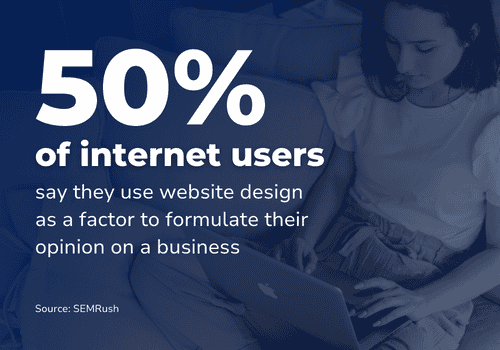
With more and more people shopping online and making comparisons between competitors before coming to a decision, it’s vital for a small business to come across as the best choice a potential customer can make.
Here’s how modern website design fosters a professional image and why it matters:
How Modern Website Design Creates a Professional Image
- Consistent Branding: Modern design ensures that every element on a website — from the colour palette and typography to the logo and layout — is consistent with the business’s brand identity. This uniformity helps establish a recognizable brand that appears more professional and trustworthy.
- Clean and Clutter-Free Layouts: Utilizing white space and minimalistic design principles, modern websites offer clean, clear, and uncluttered layouts that not only look professional but also make it easier for visitors to navigate and find the information they need quickly and efficiently.
- High-Quality Visuals: Modern websites typically use high-resolution images and videos that are professionally produced. This high level of quality in visual content reflects well on the business, suggesting a commitment to quality in all aspects of the operation.
Why a Professional Image is Important
- First Impressions: Not to overstate it, but once again we come back to the first impression a professional image provides. Instilling confidence and trust in a business’s ability to deliver quality products or services is incredibly important when so many people are researching online before making a purchase decision.
- Customer Confidence: A modern website communicates reliability and legitimacy, which are crucial for winning customer trust. Customers are more likely to engage with a business they perceive as professional and trustworthy.
- Brand Building: A well-designed website that utilizes white space effectively is an essential tool for brand building. It conveys the business’s values, personality, and professionalism, helping to create a strong, recognizable brand identity.
SEO: Leveraging Modern Web Design for Superior Search Rankings
Most consumers turn to search engines to find the products and services they need. This makes SEO a critical component of any small business’s strategy to attract initial website visitors.
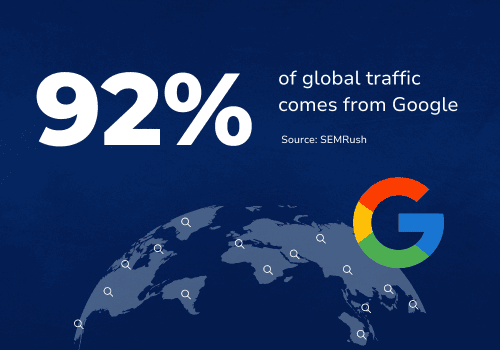
Modern website design integrates numerous SEO-friendly practices that enhance a website’s search engine visibility. This not only drives more organic traffic but also builds a strong foundation for online success, making it an indispensable strategy for any small business looking to grow.
Here’s how modern web development practices contribute to better SEO and why that’s important for a small business:
How Modern Website Design Boosts SEO Performance
- Mobile Responsiveness: Search engines, especially Google, prioritize mobile-friendly websites in their rankings because a significant portion of users accesses the internet via mobile devices. Modern web designs are built with responsive layouts that adapt seamlessly to different screen sizes, creating an engaging user experience and SEO.
- Faster Loading Times: Modern web design techniques optimize website speed by using better server performance, optimized images, and efficient coding practices. Since page speed is a known ranking factor for SEO, faster websites are more likely to rank higher in search engine results.
- Structured Data and Schema Markup: Modern websites can include structured data and schema markup. This helps search engines understand the content of the website better, enabling them to display additional information in the search results (like snippets, breadcrumbs, and ratings), which can improve click-through rates.
- Clean and Clear Navigation: A well-organized site structure with clear navigation helps search engines index your website more effectively. Modern design incorporates intuitive navigation, which not only enhances user experience but also improves site crawlability, a critical factor for SEO.
Why Better SEO Performance Is Important
- Increased Visibility: As we already mentioned, Good SEO practices increase a website’s visibility in search engine results pages (SERPs), making the business more likely to be found by potential customers. The higher a site ranks, the more clicks and traffic it will receive.
- Cost-Effective Marketing: Unlike paid advertising, SEO provides a competitive and cost-effective way for small businesses to attract new customers. The traffic generated from SEO is more targeted because it captures people in the act of searching for products or services that the business offers.
- Builds Trust and Credibility: Websites that rank higher on search engine results are generally perceived as more trustworthy and credible by users. SEO helps establish a brand’s authority through enhanced online presence and quality user interactions.
CRO: The Art and Science of Converting Visitors into Customers
The ultimate goal of any business website is conversion — turning visitors into customers. Modern website design plays a pivotal role in optimizing conversion rates by creating an environment that facilitates the smoothest and most compelling path to conversion.

For small businesses, excelling in these areas means better performance, greater customer satisfaction, and ultimately, sustained growth.
Here’s how modern designers enhance conversion rates and why that’s crucial for small businesses:
How Modern Website Design Optimizes Conversion Rates
- Simplified User Journeys: Modern websites streamline the path to conversion by minimizing the number of steps users must take to complete an action. This could involve simplifying forms, enhancing the checkout process, or refining the navigation of a website landing page to make the journey from landing page to conversion as intuitive as possible.
- Responsive and Adaptive Design: With a significant amount of traffic coming from mobile devices, modern websites ensure that all elements work seamlessly across all platforms and devices. A responsive design adjusts to the size of the device’s screen, making sure that usability is optimal, which is crucial for holding the user’s interest and facilitating conversions.
- Clear Calls to Action (CTAs): Effective modern design prominently features clear, compelling calls to action that guide users toward the next steps. Whether it’s a button, link, or interactive element, CTAs are designed to be noticeable and enticing, reducing hesitation and encouraging quicker decisions.
Why Optimizing Conversion Rates Is Important for Small Businesses
- Enhanced ROI: Higher conversion rates mean that more of the visitors driven to the site via marketing efforts are completing desired actions, thus improving the overall return on investment for marketing and website development.
- Cost Efficiency: Increasing conversions from existing traffic is more cost-effective than attracting new traffic. By optimizing their website design, small businesses can extract more value from their current visitors and customer base.
- Competitive Advantage: In competitive markets, businesses with higher conversion rates will likely outperform their competitors. Effective conversion strategies can make the difference between a thriving business and one that struggles to generate sales.
- Customer Insights: The process of optimizing conversion rates often involves detailed analytics, which can provide valuable insights into customer behavior and preferences. These insights can inform broader business strategies and help refine product offerings and marketing tactics.
10 Essential Features for Every Small Business Website
For small businesses aiming to establish a strong online presence, incorporating modern website design features is essential. These features not only enhance the aesthetic appeal but also improve functionality, usability, and overall effectiveness of the website.
Here are the 10 most essential modern website design features that every small business should consider:
1. User-Friendly Navigation
The design and organization of your website’s menu, site structure and other navigational elements should be intuitive and easy-to-use.
- What This Does: One of the most important principles of modern web design is facilitating visitors with a structure to find the information they need quickly without getting frustrated, reducing bounce rates and improving user engagement. A well-organized site helps users navigate through the pages efficiently, without getting lost or overwhelmed.
- How It’s Implemented: By designing a logical layout of menu items, including a search bar, web designers can minimize the number of clicks needed to reach desired information.
2. Responsive Design
Responsive design is a website development approach that ensures that your site looks great and functions well on all devices, from desktop to mobile.
- What This Does: When a responsive website design is implemented, your website automatically adjusts its layout and scaling to fit the screen on which it’s being viewed, including desktops, tablets, and smartphones.
- How It’s Implemented: This is achieved using CSS media queries to alter layout elements based on different screen specifications, ensuring that elements resize and reposition appropriately.
3. Fast Loading Speed
The time it takes for your website to load on a user’s device should be minimal. Slow websites frustrate users and make them leave a site prematurely, which can decrease customer satisfaction and reduce the effectiveness of your website.
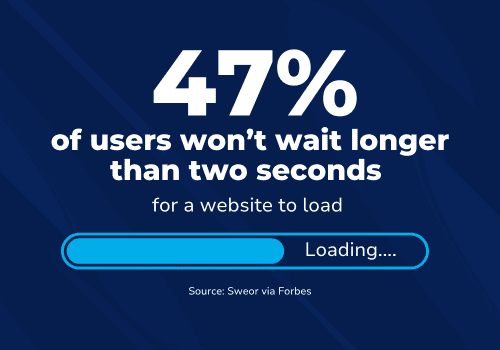
- What This Does: Modern website design ensures that sites load quickly, reducing user frustration and improving engagement — which can also help with Google rankings.
- How It’s Implemented: Techniques like optimizing image sizes, minimizing code, using browser caching, and choosing fast hosting services will all contribute to faster loading speeds.
4. White Space (Negative Space)
White space, also known as negative space, refers to the unmarked areas of a webpage that are left empty. This space isn’t necessarily white; it can be any color or even a background image that doesn’t contain any active elements like text or images.
- What This Does: White space is more visually appealing; it helps reduce clutter and improve readability by breaking up page elements and allowing the user’s eye to rest. It creates a clean and uncluttered look, which is key to a good design. Proper use of white space can highlight the most important information, direct visitors’ attention effectively toward a CTA, and make the content more digestible in general.
- How It’s Implemented: Implementing effective white space involves strategic decisions in the layout and design process, ensuring there is sufficient space around text and between different elements.
5. Professional Web Typography
The look of your website should reflect your brand’s identity. One of the best ways to make this happen is through the art and technique of arranging type to make the text legible and appealing when displayed.
- What This Does: The right typography helps to build brand recognition and trust with your audience, making your business appear more professional and reliable while also enhancing readability of your content and improving the overall user experience, which keeps visitors on your site longer.
- How It’s Implemented: Designers choose fonts that reflect your brand’s style and are easy to read. They also ensure text size and spacing are optimized for readability across devices.
6. High-Quality Visual Content
Modern web design is finding new and imaginative ways to feature high-quality visual content, whether it’s stunning photography, professionally created graphics, or custom illustrations.
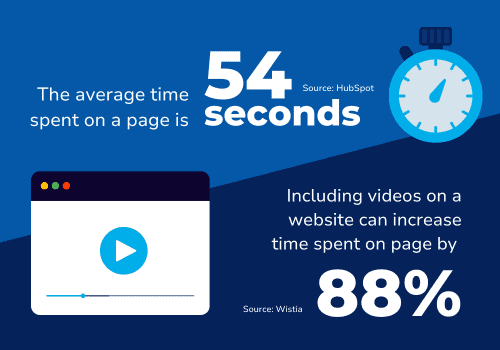
- What This Does: Site features like this make your website more engaging and appealing, while also conveying your message more effectively to attract more customers.
- How It’s Implemented: Web designers accomplish this by using high-resolution images that are optimized for the web to look great and load quickly. In addition to images, graphics, and illustrations, relevant and attention-grabbing videos alongside consistent iconography can also be used.
7. Clear Calls to Action
A call to action (CTA) is a button or link that prompts visitors to take a specific action, like “Buy Now,” “Sign Up,” or “Contact Us.”
- What This Does: They direct users explicitly on what to do next, significantly improving the conversion rates by reducing decision fatigue. Good CTAs can dramatically increase the rate at which your website converts visitors into customers.
- How It’s Implemented: Skilled web designers are able to flow content toward a CTA, gently persuading visitors to take action. The CTAs themselves should be easy to find and enticing enough to encourage visitors to click — that could mean vibrant colours or placement that draws attention from strategic locations on a landing page.
8. Live Chat and Chatbots
Real-time communication tools integrated into your website allow visitors to interact directly with your team or an automated system like a chatbot.
- What This Does: Adding elements like chatbots make your website more engaging while providing customer service that visitors can access instantly. In answering their questions, live chat and chatbots can further potential customers through your site and increase the likelihood of conversion.
- How It’s Implemented: Web developers and designers can incorporate third-party live chat services or develop custom chatbots that use artificial intelligence to interact with users on your site. These tools are typically displayed as a chat icon at the corner of the website, which users click to expand and start a conversation.
9. SSL Security
SSL (Secure Sockets Layer) is a security technology that provides encryption for the data exchanged between a web browser and a web server.
- What This Does: This helps to protect sensitive information transmitted from and to your website, such as personal details and credit card numbers.
- How It’s Implemented: Purchasing an SSL certificate and installing it on your website’s hosting account, will give your site a protected URL that begins with “https://” instead of “http://” as well as a padlock icon in the address bar. These features reassure visitors that their data is safe — and your business is legitimate.
10. Accessibility Features
Making your website accessible means ensuring that all potential users, including those with disabilities, can use it effectively.
- What This Does: This increases your site’s audience, improves user experience for everyone, and, depending on your region, likely complies with legal requirements.
- How It’s Implemented: By providing text descriptions for images (alt texts), ensuring keyboard navigability, and using sufficient contrast for those with visual impairments, designers ensure everyone can consume their website’s content without difficulty.
Each of these features contributes significantly to creating a modern, professional, and effective website. Implementing them thoughtfully will ensure that your small business not only attracts visitors but also offers them a seamless and rewarding online experience that leads to a much increased chance of sale.
Harvard Excelerate’s Design Services for Modern Websites
Considering the expertise required to integrate some of the features listed above, small businesses might be concerned about the potential costs involved in implementing modern web design elements. Certainly there are costs involved in updating a website, but:
- This initial expenditure into a website is a strategic investment proven to create an incredibly cost-effective sales and marketing tool that not only enhances user engagement but also boosts your brand’s visibility and conversion rates, ultimately driving revenue. There’s a definitive ROI from investing in modern web design; and
- Harvard Excelerate’s website design services are very affordable for small businesses. We offer cost-effective web design solutions tailored specifically for small businesses looking to maximize their online presence without breaking the bank. Our services are designed to ensure your website is not only visually appealing, but also highly functional and optimized for search engines and conversions — all at a low cost.
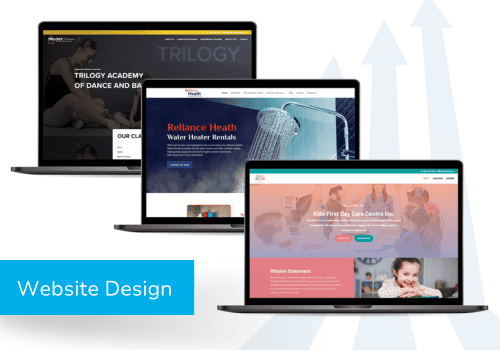
Cost-Effective Modern Web Design:
Here’s how we do it:
Modern and Streamlined Web Design
We create sleek, modern layouts that are attractive and professional, which help establish your business’s credibility and appeal to contemporary consumers.
User-Friendly Navigation Bars
Our web design includes intuitive navigation systems that make it easy for your visitors to find what they are looking for, enhancing user experience and reducing bounce rates.
Multiple Call-to-Action Buttons
We strategically place multiple CTAs across your site to guide users towards conversion, whether it’s making a purchase, signing up for a newsletter, or contacting your business. These strategic website design elements increase the likelihood of converting visits into sales.
Well-Crafted Title Tags and Metadata
We optimize all your page titles and metadata with SEO best practices to improve your site’s visibility on search engines, making it easier for potential customers to find you online.
Responsive Web Design for Seamless Mobile Experience
With mobile traffic often surpassing desktop, our responsive design provides a seamless experience across all devices, crucial for keeping mobile users engaged and willing to convert.
Consistent Adherence to Google’s Best Practices
We keep up-to-date with the latest SEO guidelines from Google, adhering to the practices that will rank it high in search results.
Partner with Harvard Excelerate for Your Modern Website Needs
With Harvard Excelerate’s cost-effective solutions, your business can enjoy all the advantages of modern web design without overextending your budget.
By integrating these features, Harvard Excelerate empowers your site to become the type of salesperson your business needs; one that works tirelessly to increase your brand’s online visibility, attract more leads, and convert those leads into customers — all of which are essential for the continued growth of your business.You know your website is capable of being the best salesperson your business has. It’s time to put it to work. Transform your site into a powerful sales and marketing tool by reaching out to Harvard Excelerate today for a free web design quote.



